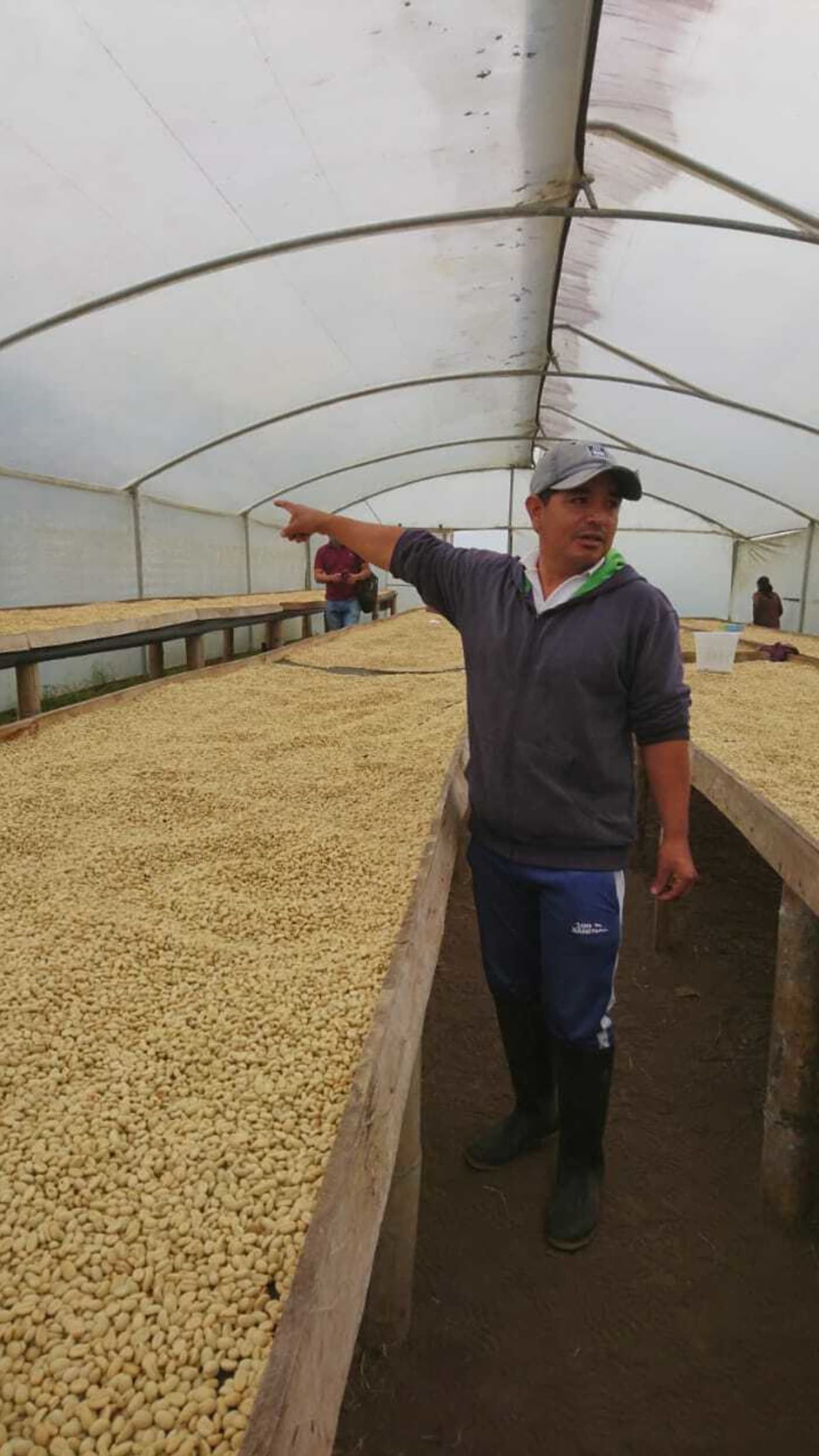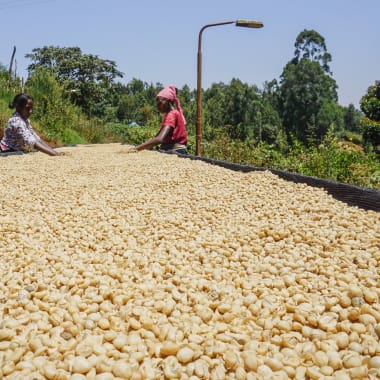-
Producer
-
Wilter Guillermo Lomas Lopez
-
Country
- Ecuador
-
Region
-
Parroquia
-
Altitude
-
1370m above sea level
-
Varieties
-
Process
-
Harvested
-
September 2023
-
Importer
-
Caravela
-
Body
-
-
Acidity
-
-
Tasting notes
-
Toffee apple, lemon sherbet
-
Roast style
Ecuador
Finca La Colina
Many competitors choose Sidra, one of the varietals here alongside Typica, for its cupping quality (comparable to Gesha’s). This cup is sweet and silky with lots of candy-like flavours. We taste toffee apple and lemon sherbet.
It’s the third time that Wilter Guillermo, from Finca La Colina, makes it to our VS department. This lot features a mix of Typica and Sidra varietal, fermented through a washed process.
VERY SPECIAL
You may remember La Colina’s previous VS features—a lovely washed Sidra shared in March 2023 and a silky washed Typica in May of the same year. The lot we’re sharing this time is a mix of both varieties that are still worthy of a spot in our VS lineup. Here’s why.
First is the varietal, Sidra. As we mentioned back then, it’s rare, not even listed on the World Coffee Research archive (as of March 2024). Some whisper that it “originated from a Nestlé coffee breeding facility in the region, which developed hybrids using Ethiopian and Bourbon varieties.” Something more solid is its reputation for cupping potential, as more and more World Coffee Championship competitors choose it alongside Geisha.
Second is the higher-than-average price. Compared to similar quality lots from other origins, this one sits on the top end. This is due to a complex combination of political, economic and social factors (that we’ll try to summarise below).
Because of this, and because its cupping presence and flavour profile are as refined as they get, this lot by Guillermo Walter from Finca La Colina is our choice for this month’s Brew Crew VS delivery.

ECUADOR: IT’S COMPLICATED
As Caravela Coffee tells us, the high price of Ecuadorian green coffees comes down to (1) low national supply/high global demand, (2) low productivity and yields compared to other producing countries and (3) very high costs of production (~2 times more expensive compared to its neighbours, caused by Ecuador’s dollarized economy). Add to this the toll of emigration, pushing the average age of farmers to “60 years old”. It really is complicated.
If we dig deeper, we find a curious aspect that may contribute to this global imbalance: Ecuador’s status as one of the largest exporters of instant coffee. Yes, quite weird.
While the country produces a small portion of the global green coffee output, it’s one of the largest exporters of instant coffee ( mainly to Germany and Russia, where this country has a wide presence and established reputation). To do that, they import high volumes of green coffee from other countries like Vietnam, which they mix, process and finally sell as a finished soluble (Ecuadorian) product.
For national coffee producers, it’s easy to enter this established market; it offers low risk and decent rewards. On the contrary, producing specialty coffee brings a lot of unknowns, fierce global competition and selling prices that are hard to match. No wonder there are few who dare.
On the bright side, looking at the future, there is a blooming generation of growers who believe there’s a fair life and business to be made by producing high-quality arabica beans. One of them is Wilter Guillermo—respect.
WILTER GUILLERMO’S GIG
Like everyone here, Guillermo’s days start with a cup of coffee; he loves drinking it. Unlike everyone here, Guillermo decided to transform this passion into his profession, and even though he had no experience, he started his own coffee farm—Finca La Colina.
In 2014, he planted the first coffee trees. Even though he didn’t know much, the first harvest went relatively well; he made mistakes, and he learnt from them, but he also had many wins. It was all personal growth and self-learning, a dream come true.
In 2016, he produced a decent output: 540 kilograms of high-quality dry parchment that entered the specialty coffee market and, later that year, achieved 5th place in the Taza Dorada competition. Not bad for a beginner.

TYPICA VARIETAL
Typica is rare to see these days. It’s not because it’s a new variety—its origins can be traced back to sometime in the 15th or 16th century when it was taken to Yemen, then India, Java, Netherlands, Paris… and finally, Central America.
Until the 1940s, most coffee plantations in South and Central America were planted with Typica, but due to its low yield and high susceptibility to major coffee diseases, it has gradually been replaced with other varieties. Today, it’s still mainly planted in the Dominican Republic, Jamaica (where it is called Jamaica Blue Mountain)and Peru because it still offers a good or high-quality cup.
Learn more about the long travels of Typica at the World Coffee Research page, from which we’ve sourced this information.
SIDRA VARIETAL
Sidra (also known as Sydra or Bourbon Sidra) is a relatively new hybrid varietal descending of Red Bourbon and Typica. It has acquired the sweetness and the body of the first and the bright taste and acidity of the second.
According to Daily Grind, it is believed that Sidra comes from the Pichincha province in Ecuador, where it may have been created as a research project by a Nestlé local breeding facility that developed hybrids using Ethiopian and Bourbon varieties.

THIS LOT’S PROCESS
The cherries have grown at a relatively low altitude (~1370 masl) under partial shade provided by Guamo and Plantain trees. After being picked completely ripe, they’ve been fully washed and fermented for 14 hours, then dried on raised beds in a covered patio.
Learn everything about this coffee:
Ethical, traceable sourcing
This page has all the sourcing information (variety, process, region, story, importer, and more) that our importers share with us, and give us permission to use.
The transparency helps us talk confidently about the quality and background of our product, and it helps you know exactly what you’re buying.
Learn more:
Coffee page transparency legend
Our coffee philosophy
Our business approach
Fresh harvest coffee
We only source and roast coffee from each country’s latest harvest season (so the green coffee is never older than 1 year from the time of picking, processing and packing). This ensures the sensory qualities are always at their peak and unaffected by excessive ageing.
Roasted for espresso and filter (best enjoyed black)
Roast style: omni. Omni roasts are designed to brew and taste great both as espresso and filter. Our omni single origins generally sit on Agtron values in the ~70-60 value range. So, technically, they are somewhere in the lighter side of the medium spectrum.
Designed for espresso and filter brewing. Best enjoyed black.
Learn more:
Our Loring Kestrel S35 roaster
Our roasting style and approach
Best brewed within days 15-49 post-roast
The ‘fresh is best’ saying doesn’t apply to coffee (contrary to popular belief). Waiting before opening and brewing your bag of whole coffee beans helps develop peak flavour and acidity.
But heads up: if you buy pre-ground coffee, brew it as soon as possible.
Learn more:
Our recommended brewing window
Try our custom brewing recipes
Our recipes and ratios are tailored to our coffee sourcing and roasting styles, bringing the best flavour and feel out of each coffee.
For pour over, immersion, and other filter brewing styles, check our brew guides.
For our espresso single origins, we recommend a coffee:yield ratio of 1:3:
- Dose: 20g ground coffee
- Yield: 60g espresso
- Total brew time: ~24-28 seconds
This is just a starting point! We encourage you to experiment, taste, and adjust to find the recipe that you enjoy the most.
Learn more:
Our espresso brew guide (single origin)
Brewing ratio calculator
Packaging and sustainability
- Bags: ABA-certified home compostable (AS 5810-2010)
- Labels: recyclable
- Valves (only on +250g bags): general waste
- Box and tape (online orders): recyclable
Learn more:
Our packaging
Varieties
Sidra variety
Sidra (also known as Sydra or Bourbon Sidra) is a new hybrid varietal, made of Red Bourbon and Typica and combines characteristics of these two varieties. It has acquired the sweetness and the body of Red Bourbon and the bright taste and acidity of Typica.
Typica variety
Considered to be one of the ‘genus’ varietals from which all other varietals have mutated from
The location
Coffee from Ecuador
For a long time most of Ecuador’s coffee production was for commodity grade export or the production of soluble coffees (freeze dried coffee). Only in the last few years has the potential of the country’s coffee production been really explored. We’re very excited about the potential Ecuador and have some truly exceptional coffees
Farm processes
Washed process
Machines are used to remove the flesh from the coffee cherry before being fermented in water, washed again, and finally sun dried. This process tends to result in more distinct, cleaner flavours.

Subscribe to a world of coffee
Discover a new single origin coffee from Sample every 1-5 weeks with no delivery fees.
No up-front purchase, and you can pause, cancel, or change plans at any time.
Available to order online this week:

Nicaragua Guillermo Montenegro
Flavours of plum, nectarine, shortbread
Body Acidity
Washed Caturra
March 2025 harvest
Roasted omni for filter and espresso
Nicaragua Guillermo Montenegro online
Ethiopia Bekele Gemeda
Flavours of mandarin, white peach, mango
Body Acidity
Washed Ethiopian Heirloom
November 2024 harvest
Roasted omni for filter and espresso
Ethiopia Bekele Gemeda online
Colombia Carlos Imbachi Pink Bourbon
Flavours of pear, jasmine, sugarcane
Body Acidity
Washed Pink Bourbon
February 2025 harvest
Roasted omni for filter and espresso
Colombia Carlos Imbachi Pink Bourbon online
Kenya Karindundu Aa
Flavours of orange marmalade, grapefruit, Yunnan red tea
Body Acidity
Washed Batian, SL28, SL34, Ruiru 11
Roasted omni for filter and espresso
Kenya Karindundu Aa online